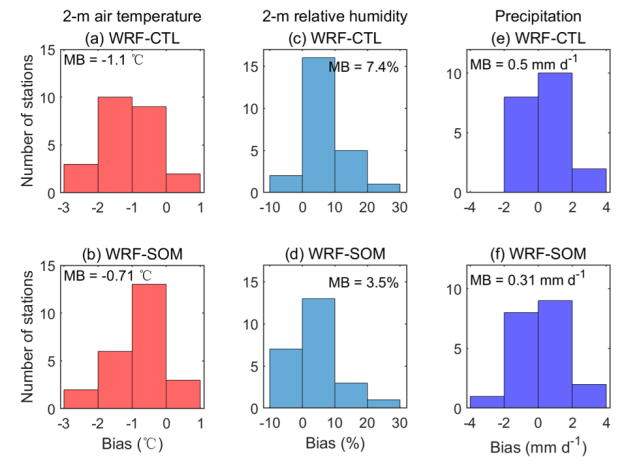The eastern Tibetan Plateau is rich in soil organic matter (SOM), which increases the amount of water the soil can hold while decreasing the rate at which heat moves through it. Previous studies have mostly discussed the impact of SOM on soil hydrothermal state from the perspective of soil thermal properties based on land surface process model, but how the plateau SOM influences the coupled land-atmosphere system remain unclear.
To address the above problem, Professor Yang Kun’s Research Group of the Department of Earth System Science (DESS), Tsinghua University, with the help of regional climate simulation, land surface process simulation and observation data, systematically investigates into the impact of SOM on land-atmosphere coupling in summer the Tibetan Plateau from the perspectives of land-atmosphere interaction and hydrothermal properties. In this study, the parametric scheme describing the SOM impact on soil hydrothermal properties based on the previous observation and development of the Tibetan Plateau is coupled into the WRF model, and two groups of numerical simulation tests are designed on this basis: the first group of tests (WRF-CTL) does not consider SOM and set its content to zero; the second group (WRF-SOM) considers SOM based on high-resolution soil data. The results show that considering the impact of SOM, the cold and humidity bias of the WRF model for the simulation of the Tibetan Plateau can be reduced to some extent (Fig. 1).

Fig. 1. Biases of summer (a-b) 2-m air temperature, (c-d) 2-m relative humidity, and (e-f) precipitation simulations from the WRF-CTL and WRF-SOM experiments relative to in-situ observations at meteorological stations on the eastern TP. In the figure, the abscissa represents the bias, the ordinate represents the number of stations, and the numbers in the figure represent the average bias of all stations. The difference between the upper and lower diagrams shows that the bias of cold and humidity decreases after considering the impacts of organic matter in the model.
The further analysis based on WRF coupled simulation test shows that the soil water content increases due to the existence of plateau SOM, but the increase is less than that of soil porosity, so it reduces the surface soil wetness, defined as the ratio of surface soil liquid water content to porosity, thus increasing sensible heat flux and reducing evaporation, making the near-surface atmosphere warm and dry. At the same time, SOM contributes to shallow soil warming and deep soil cooling by decreasing 359 the thermal conductivity and thus reducing the thermal inertia of soil. In other words, SOM on the Tibetan Plateau has the functions of heating and drying the near-surface atmosphere, and humidifying and cooling the deep soil (Fig. 2). In the past, offline land surface simulation was generally used to study the effects of SOM. If coupled simulation is used, would the results be different? By comparing the results of WRF coupled simulation and offline land surface simulation, it is found that the cooling effect of plateau SOM on deep soil may have been overestimated in offline land surface process simulation (without considering atmospheric feedback) (Fig. 3).
To sum up, bringing SOM process into the coupled climate model not only improves the description of atmospheric energy and water cycle, but also finds that the offline land surface simulation in the past may overestimate the cooling effect of SOM on soil, which means that the SOM protective effect on frozen soil may have been overestimated in early offline simulations. It is important to note that these findings do not apply to wetlands.

Fig. 2 Schematic diagram of soil organic matter (SOM) impacts on the atmosphere and soil. The color map of the TP represents the distribution of surface SOM mass content: the redder the color, the higher the SOM content; the bluer the color, the lower the SOM content. The existence of plateau SOM can change soil properties and land-atmosphere feedback, thus heating and drying the near-surface atmosphere but humidifying and cooling the deep soil.

Fig. 3 Boxplots of soil temperature differences in four layers (surface: 0-10 cm; subsurface: 10-40 cm; layer-3: 40-100 cm; layer-4: 100-200 cm) in the TP in coupled (blue; WRF-SOM minus WRF-CTL) and offline (black; LSM-SOM minus LSM-CTL) simulations, binned into four classes according to surface SOM mass content. In the figure, the abscissa represents the variation range of SOM mass content in the surface layer, and the ordinate represents the difference of soil temperature simulation value between tests considering and not considering SOM (the former minus the latter). Figures a-d shows the difference of soil temperature in surface layer, subsurface layer, layer-3 and layer-4 respectively. Compared with coupled simulation, offline simulation overestimates the cooling effect of plateau SOM on deep soil because it does not consider atmospheric feedback.
The related research has been published in Journal of Hydrometeorology as an article titled “Land–Atmosphere Feedbacks Weaken the Cooling Effect of Soil Organic Matter Property toward Deep Soil on the Eastern Tibetan Plateau”. Doctoral candidate Sun Jing of the DESS, Tsinghua University is the first author of the paper, and Professor Yang Kun of the DESS is the corresponding author. Other co-authors include Associate Professor Lu Hui of the DESS, Tsinghua University, Special Research Assistant Zhou Xu, Researcher Li Xin and Associate Professor Chen Yingying of the Institute of Tibetan Plateau Research, Chinese Academy of Sciences, Professor Guo Weidong of Nanjing University and Associate Professor Jonathon S. Wright of the DESS, Tsinghua University. This work was supported by National Key Research and Development Program of China (Grant 2018YFA0605400) and Basic Science Center for Tibetan Plateau Earth System (BCTPES; NSFC project 41988101).
Full-text link of the article: https://doi.org/10.1175/JHM-D-22-0074.1
Written by Sun Jing and Yang Kun